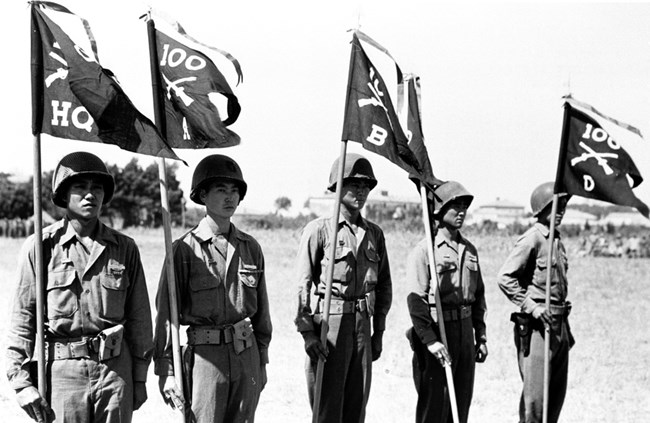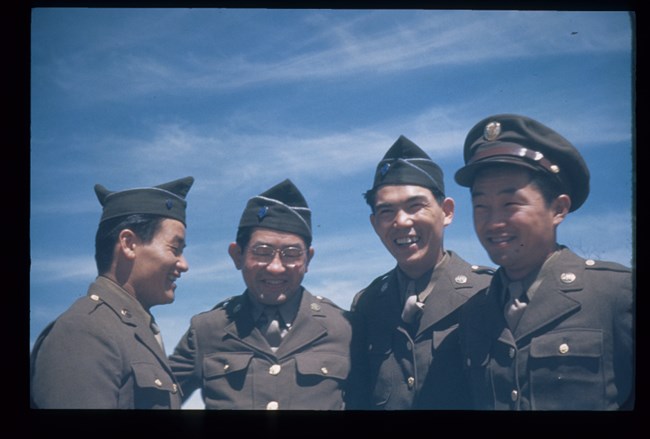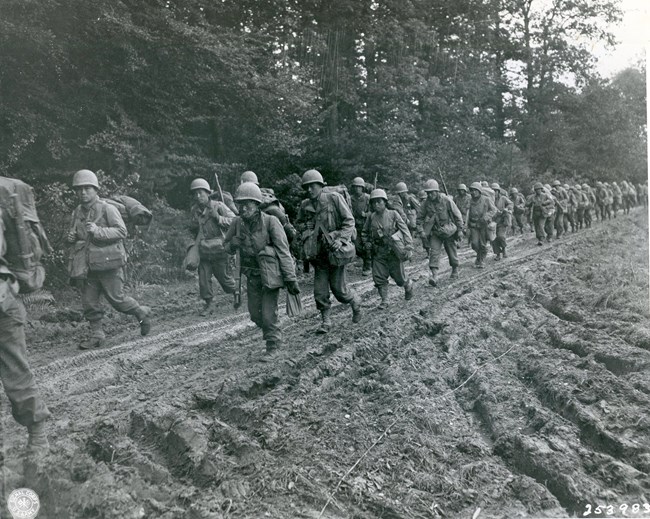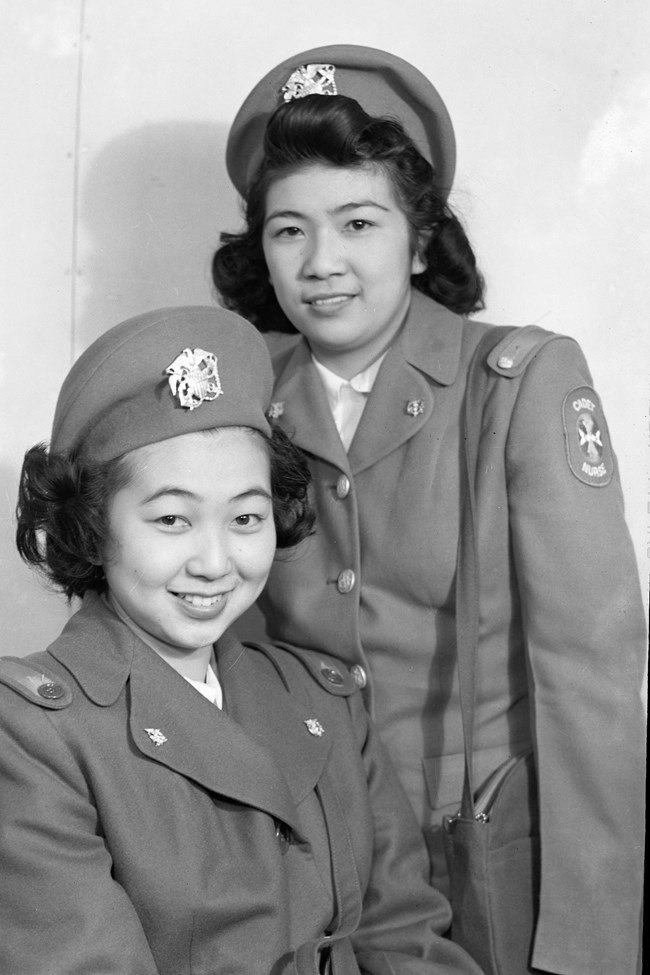Last updated: July 28, 2025
Article
Nisei Military Service
Background on Japanese American Military Service
In the immediate aftermath of the attack on Pearl Harbor, many Selective Service boards rejected Nisei would-be volunteers, classifying them as 4-F or 4-C (ineligible for service because of race or ancestry). The War Department prohibited further Nisei induction after March 31, 1942.
There were roughly 5,000 Japanese Americans serving in the military by December 1941, many of whom were drafted following the passage of the Selective Service and Training Act of 1940, the first peacetime draft in U.S. history. In Hawai’i, Nisei soldiers made up a significant portion of two regiments of the Hawai’i National Guard. When Imperial Japan attacked Pearl Harbor, about 600 Japanese Americans were in training at Schofield Barracks in central Oahu.
As restrictions tightened for Japanese Americans living on the West Coast and forced removal began to seem inevitable, some Nisei in the Army refused to submit to combat training, citing discriminatory treatment and, beginning in 1942, the incarceration of their families. Some of these men were court-martialed, dishonorably discharged, and served prison terms; others ended up in War Department Special Organizations assigned to perform manual labor. Many more of these men, though, volunteered for combat training and would become replacements for the 442nd Regimental Combat Team.
Nisei Service During WWII
Formation of the 100th Battalion

Courtesy of the National Archives and Records Administration
In near total secrecy, Hawai’i’s military governor formed the Nisei soldiers of the Hawai’i National Guard into a battalion. In early June 1942, 1,432 men shipped out to San Francisco and then Camp McCoy in Wisconsin. They trained for six months, becoming the original members of the 100th Infantry Battalion.
As the government deliberated on whether Japanese American soldiers would be permitted to serve on combat duty overseas, the men of the 100th were transferred to Camp Shelby in Mississippi. There, they were joined in early 1943 by the new recruits of the 442nd Regimental Combat Team.
The 442nd Regimental Combat Team

Courtesy of Amache Preservation Society, McClelland collection.
On February 1, 1943, President Roosevelt announced the formation of the 442nd Regimental Combat Team, a segregated all-Japanese American unit in the Army with predominantly white officers. The creation of this unit followed months of debate within the U.S. government and the military about whether Japanese Americans should be able to serve in the military. Some Japanese Americans, like Japanese American Citizens League leader Mike Masaoka, encouraged the government to allow Nisei to volunteer in order to prove their loyalty. Ultimately, despite opposition from military leadership and WRA director Dillon Myer, Elmer Davis of the Office of War Information made the argument to Roosevelt in a letter that Nisei soldiers could be a useful propaganda weapon to counter Japanese claims of American racism.
As the 100th Battalion continued training at Camp Shelby in Mississippi and as the Military Intelligence Service Language School began sending trained linguists to the battlefields of the Pacific, the call went out for volunteers for the 442nd Regimental Combat Team.
Initially, the military set a goal for 3,000 Japanese American volunteers from the continent and 1,500 volunteers from the Territory of Hawai’i. However, it quickly became clear that those quotas would need to be reversed. 1,500 Nisei men from the continent, many incarcerated with their families, and 2,686 Nisei from Hawai’i volunteered.

Courtesy of the National Archives and Records Administration
The newly formed 442nd arrived at Camp Shelby in the spring of 1943, joining the men of the 100th. At Camp Shelby, the volunteers from Hawai’i often clashed with the volunteers from the continent. Despite shared ancestry, the experiences of Japanese Americans from Hawai’i and Japanese Americans from the continent were vastly different and cultural differences at times led to conflict.Gradually, the 442nd began to coalesce as a unit, especially once a relationship was established between the Nisei soldiers and Japanese Americans incarcerated at nearby Rohwer and Jerome, in southeastern Arkansas.
The 100th Infantry Battalion shipped out to the front in August 1943, landing in North Africa and joining the fighting in Italy, suffering the first casualties. In June of 1944, the 442nd arrived in Europe to join the 100th. The 100th became the first battalion of the 442nd and kept its designation as a marker of its exceptional reputation and fighting record.
During the course of the war, the 100th/442nd earned the respect of fellow soldiers and military leadership alike, despite ongoing racist attitudes. One of the more famous exploits of the Nisei soldiers is known as the “Rescue of the Lost Battalion,” during which Nisei soldiers rescued a group of soldiers from Texas who were surrounded by German troops. The Nisei were successful after two failed attempts by other units—but at an incredible cost. In 1945, the 522nd Field Artillery Battalion of the 442nd participated in the liberation of one of the subcamps of the Dachau death camp.
After less than two years of combat, the 100th/442nd suffered about 800 casualties. They won seven Distinguished Unit Citations—the last of which was awarded personally by President Truman. Over 4,000 Purple Hearts, 29 Distinguished Service Crosses, 588 Silver Stars, and more than 4,000 Bronze stars were awarded to the 100th/442nd during the war. In 1946, one Nisei soldier, Sadao S. Munemori, received the Medal of Honor posthumously. After years of activism and a Congressional mandate, 20 Distinguished Service Crosses were upgraded to Medals of Honor. On June 21, 2000, President Bill Clinton presented the medals, honoring seven veterans who were still living and 13 veterans posthumously.
Military Intelligence Service
In November 1941, as war with Japan loomed, the Military Intelligence Service (MIS) Language School opened at the Presidio in San Francisco with a class of 60 students, 58 of whom were Japanese American, taught by four Nisei instructors. The MIS Language School moved to Minnesota—first Camp Savage and then Fort Snelling—in June 1942. To meet the increasing need for linguists, the MIS recruited volunteers from the WRA prison camps on the continent and from Hawai’i. 200 members of the 100th Infantry Battalion were transferred to the MIS Language School in December 1942. In 1943, linguists were also recruited from the 442nd Regimental Combat Team.
Nisei Women in the Military

Courtesy of the National Archives Records Administration
In May 1942, Congress passed a bill that allowed women to support the American military by founding the Women’s Army Auxiliary Corps (WAAC). On July 1, 1943, the WAAC became part of the U.S. Army and was renamed the Women’s Army Corps (WAC).
Japanese American women were not permitted to join the WAC until November 1943, when the War Department lifted restrictions on their service. Although Nisei men served in segregated units, Nisei women who joined the WACs were not segregated because their number was too small to form a separate corp.
Some Nisei WACs were trained as linguists and served as translators during the war and afterwards in postwar Japan.
Other Nisei women joined the Cadet Nurse Corps, many leaving camp with the assistance of the National Japanese American Student Relocation Committee (NJASRC) to attend accelerated nursing programs.
Nisei Military Service at NPS Sites
There are multiple sites within the National Park Service that deal with the story of Japanese American incarceration during WWII. Each had varying levels of military service associated with them. Click the site to read more.
By the end of World War II, 953 Japanese American men and women from Amache—nearly ten percent of the camp’s population—served in the US military. They volunteered for or were drafted into the segregated 442nd Regimental Combat Team, the Military Intelligence Service (MIS), the Women’s Army Corps (WAC), and the Cadet Nursing Corps. Amache’s volunteer rate was the highest of the ten War Relocation Authority prison camps. 31 Nisei soldiers from Amache were killed during the war, while their families remained behind barbed wire. One of these men, Kiyoshi K. Muranaga, was posthumously awarded the Medal of Honor, the military’s highest honor, in 2000. The names of these 31 servicemen killed in action are inscribed on a monument at the Amache cemetery.
Sixty–six men and two women from Bainbridge Island's Nikkei community served in the armed services during WWII, joining more than 33,000 nationwide. Six Island Nisei were already serving in the Army when the war began. The 442nd Infantry Battalion included sixteen men from Bainbridge Island. Mo Nakata, Art Koura, and William Okazaki were the first Islanders seriously injured with the 442nd. The Military Intelligence Service also including sixteen Island men.
About 60 people at Honouliuli had connections to military service, either they themselves served (WWI, WWII) or sons or brothers. People served in the 100th, 442nd, and MIS. One individual was Sanji Abe, a US Army veteran of WWI. During his time at Honouliuli, two of his sons served in the US Army, with the 100th in the medical detachment and MIS. Sanji Abe would go on to be the first Japanese American elected to the Senate of the Territory of Hawaii.
Tags
- amache national historic site
- honouliuli national historic site
- manzanar national historic site
- minidoka national historic site
- pearl harbor national memorial
- presidio of san francisco
- military service
- world war ii
- asian american and pacific islander history
- japanese american
- japanese american confinement
- japanese american incarceration
